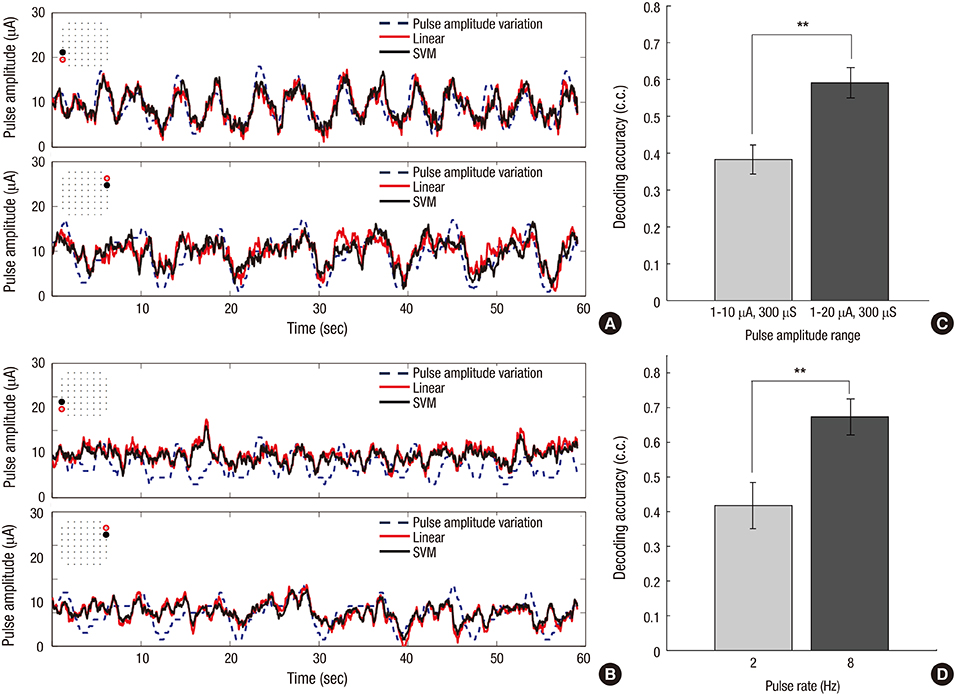J Korean Med Sci.
2017 Jun;32(6):900-907. 10.3346/jkms.2017.32.6.900.
Amplitude Modulation-based Electrical Stimulation for Encoding Multipixel Spatiotemporal Visual Information in Retinal Neural Activities
- Affiliations
-
- 1Department of Biomedical Engineering, Yonsei University Wonju College of Health Science, Wonju, Korea. khkim0604@yonsei.ac.kr
- 2Department of Physiology, Chungbuk National University School of Medicine, Cheongju, Korea.
- KMID: 2377718
- DOI: http://doi.org/10.3346/jkms.2017.32.6.900
Abstract
- Retinal implants have been developed as a promising way to restore partial vision for the blind. The observation and analysis of neural activities can offer valuable insights for successful prosthetic electrical stimulation. Retinal ganglion cell (RGC) activities have been investigated to provide knowledge on the requirements for electrical stimulation, such as threshold current and the effect of stimulation waveforms. To develop a detailed "˜stimulation strategy' for faithful delivery of spatiotemporal visual information to the brain, it is essential to examine both the temporal and spatial characteristics of RGC responses, whereas previous studies were mainly focused on one or the other. In this study, we investigate whether the spatiotemporal visual information can be decoded from the RGC network activity evoked by patterned electrical stimulation. Along with a thorough characterization of spatial spreading of stimulation current and temporal information encoding, we demonstrated that multipixel spatiotemporal visual information can be accurately decoded from the population activities of RGCs stimulated by amplitude-modulated pulse trains. We also found that the details of stimulation, such as pulse amplitude range and pulse rate, were crucial for accurate decoding. Overall, the results suggest that useful visual function may be restored by amplitude modulation-based retinal stimulation.
Keyword
Figure
Reference
-
1. Ryu SB, Ye JH, Goo YS, Kim CH, Kim KH. Temporal response properties of retinal ganglion cells in rd1 mice evoked by amplitude-modulated electrical pulse trains. Invest Ophthalmol Vis Sci. 2010; 51:6762–6769.2. Merabet LB, Rizzo JF, Amedi A, Somers DC, Pascual-Leone A. What blindness can tell us about seeing again: merging neuroplasticity and neuroprostheses. Nat Rev Neurosci. 2005; 6:71–77.3. Zrenner E, Bartz-Schmidt KU, Benav H, Besch D, Bruckmann A, Gabel VP, Gekeler F, Greppmaier U, Harscher A, Kibbel S, et al. Subretinal electronic chips allow blind patients to read letters and combine them to words. Proc Biol Sci. 2011; 278:1489–1497.4. Barry MP, Dagnelie G, Argus II. Study Group. Use of the Argus II retinal prosthesis to improve visual guidance of fine hand movements. Invest Ophthalmol Vis Sci. 2012; 53:5095–5101.5. Pérez Fornos A, Sommerhalder J, da Cruz L, Sahel JA, Mohand-Said S, Hafezi F, Pelizzone M. Temporal properties of visual perception on electrical stimulation of the retina. Invest Ophthalmol Vis Sci. 2012; 53:2720–2731.6. Ryu SB, Ye JH, Goo YS, Kim CH, Kim KH. Decoding of retinal ganglion cell spike trains evoked by temporally patterned electrical stimulation. Brain Res. 2010; 1348:71–83.7. Ryu SB, Ye JH, Goo YS, Kim CH, Kim KH. Decoding of temporal visual information from electrically evoked retinal ganglion cell activities in photoreceptor-degenerated retinas. Invest Ophthalmol Vis Sci. 2011; 52:6271–6278.8. Cottaris NP, Elfar SD. Assessing the efficacy of visual prostheses by decoding ms-LFPs: application to retinal implants. J Neural Eng. 2009; 6:026007.9. Jensen RJ, Rizzo JF 3rd. Activation of ganglion cells in wild-type and rd1 mouse retinas with monophasic and biphasic current pulses. J Neural Eng. 2009; 6:035004.10. Fried SI, Hsueh HA, Werblin FS. A method for generating precise temporal patterns of retinal spiking using prosthetic stimulation. J Neurophysiol. 2006; 95:970–978.11. Stett A, Barth W, Weiss S, Haemmerle H, Zrenner E. Electrical multisite stimulation of the isolated chicken retina. Vision Res. 2000; 40:1785–1795.12. Lewicki MS. A review of methods for spike sorting: the detection and classification of neural action potentials. Network. 1998; 9:R53–78.13. Bialek W, Rieke F, de Ruyter van Steveninck RR, Warland D. Reading a neural code. Science. 1991; 252:1854–1857.14. Warland DK, Reinagel P, Meister M. Decoding visual information from a population of retinal ganglion cells. J Neurophysiol. 1997; 78:2336–2350.15. Hoegaerts L, Suykens JA, Vandewalle J, De Moor B. Subset based least squares subspace regression in RKHS. Neurocomputing. 2005; 63:293–323.16. Jensen RJ, Rizzo JF 3rd. Activation of retinal ganglion cells in wild-type and rd1 mice through electrical stimulation of the retinal neural network. Vision Res. 2008; 48:1562–1568.17. Ryu SB, Ye JH, Lee JS, Goo YS, Kim CH, Kim KH. Electrically-evoked neural activities of rd1 mice retinal ganglion cells by repetitive pulse stimulation. Korean J Physiol Pharmacol. 2009; 13:443–448.18. Greenwald SH, Horsager A, Humayun MS, Greenberg RJ, McMahon MJ, Fine I. Brightness as a function of current amplitude in human retinal electrical stimulation. Invest Ophthalmol Vis Sci. 2009; 50:5017–5025.19. Stasheff SF. Emergence of sustained spontaneous hyperactivity and temporary preservation of OFF responses in ganglion cells of the retinal degeneration (rd1) mouse. J Neurophysiol. 2008; 99:1408–1421.20. Eckmiller R, Neumann D, Baruth O. Tunable retina encoders for retina implants: why and how. J Neural Eng. 2005; 2:S91–104.21. Freeman DK, Rizzo JF 3rd, Fried SI. Encoding visual information in retinal ganglion cells with prosthetic stimulation. J Neural Eng. 2011; 8:035005.22. Drasdo N, Fowler CW. Non-linear projection of the retinal image in a wide-angle schematic eye. Br J Ophthalmol. 1974; 58:709–714.23. Legge GE, Ahn SJ, Klitz TS, Luebker A. Psychophysics of reading--XVI. The visual span in normal and low vision. Vision Res. 1997; 37:1999–2010.
- Full Text Links
- Actions
-
Cited
- CITED
-
- Close
- Share
- Similar articles
-
- Electrically-evoked Neural Activities of rd1 Mice Retinal Ganglion Cells by Repetitive Pulse Stimulation
- Accurate Representation of Light-intensity Information by the Neural Activities of Independently Firing Retinal Ganglion Cells
- Comparison of Retinal Ganglion Cell Responses to Different Voltage Stimulation Parameters in Normal and rd1 Mouse Retina
- Visually Evoked Sympathetic Skin Response in Normal Subjects
- Multiple consecutive-biphasic pulse stimulation improves spatially localized firing of retinal ganglion cells in the degenerate retina






